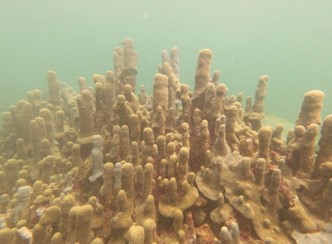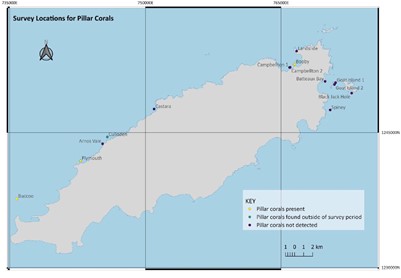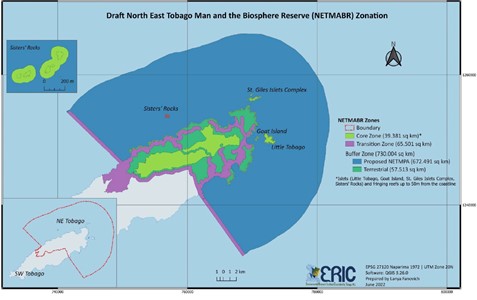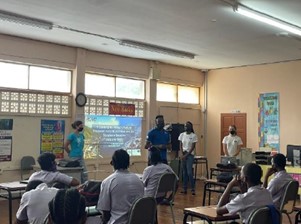Background:
North-East (NE) Tobago is Trinidad & Tobago’s most iconic conservation landscape. It is a rare and largely intact ecosystem that includes the world’s oldest tropical rainforest reserve, one declared in 2019 (Tobago Main Ridge Forest Reserve) and two candidate Natural National Heritage (NNH) Sites, a multitude of proposed Cultural National Heritage (CNH) Sites, a planned marine protected area (MPA) of coral reefs and open ocean, and three Important Bird and Biodiversity Areas (IBA).
The declaration of NE Tobago as a UNESCO Man and the Biosphere Reserve (UNESCO MAB Reserve) on 28 Oct 2020 indicates the area’s global significance and potential as a place where ecosystem services directly support sustainable economic development, conservation, research, culture and education and simultaneously create outstanding synergies to the benefit of all stakeholders.
The pillar coral (Dendrogyra cylindrus) (Figure 1) is an iconic species of hard coral that produces up to 4m high columns of single-sex colonies, making them an important reef builder. It is a very rare coral species with a highly fragmented population structure in Tobago, listed as ‘Vulnerable’ by the IUCN and listed under the Annex III of the SPAW Protocol. Pillar coral colonies grow in shallow costal waters and can significantly contribute the reduce coastal erosion.
Few remaining colonies has been observed kilometres apart and in spread-out locations in Tobago, illustrating the difficulties for this species to reproduce naturally because pillar corals sexes are separated and successful reproduction requires a male close to a female. Reproductive isolation, lack of recruitment, anthropogenic impacts, climate change impacts (bleaching events in 2005 and 2010), lack of information on and awareness of pillar corals are the species’ biggest vulnerabilities.
Urgent and innovative intervention is needed for the conservation of the pillar coral’s resilience against present and future stressors in Tobago, by increasing existing colonies size and sexual reproduction opportunities.

Goals and Objectives :
The project intitled « Reef-building Pillar Coral Restoration and Strengthening the Level of Protection for Critical Reef Ecosystems in the North-East Tobago UNESCO Man and the Biosphere Reserve » was implemented by Environmental Research Institute Charlotteville (ERIC) between May 2021 and August 2022.
The project was composed of two components to develop a regionally replicable coral restoration effort and improve legal protection of vulnerable reefs in the North East Tobago UNESCO MAB Reserve in order to contribute to the reduction of coastal risks and adaptation to climate change:
1) Avoid the extirpation of coastal-reef-building pillar corals in NE Tobago which significantly contribute to coastal erosion reduction. The project proposed to map the remaining pillar coral colonies, determine their sex and bring males and females together so natural reproduction can be restarted. All restoration activities took place in areas with minimal human impact and adhered to best coral restoration practises; out-planted colonies and surroundings will be monitored every two months.
2) A technical documentation was provided to efficiently and effectively increase the level of legal protection for coastal reefs in the entire NE Tobago UNESCO MAB Reserve and four small islets, two of which are IBAs, recognised for their significant seabird colonies. It is important to note that currently there is no legal protection of these reefs; listing them as NNHs will allow to prohibit reef damages, unsustainable fishing and other human threats. Once the site is designated as NNH, the reefs will be included as “Core Zones” in the UNESCO MAB Reserve
Main results:
Sub Goal 1 : The extirpation of coastal, reef-building IUCN (VU), Pillar corals in the North-East Tobago UNESCO MAB Reserve is prevented, leading to increased densities and coastal risk reduction.
Documentation of the status and distribution of the remaining pillar corals in Tobago
- A literature review on the pillar coral biology, ecology, reproduction, conservation and distribution was completed
- A total of 18 potential sites were identified (from literature review and consultations)
- two trainings in the underwater visual census method and specimen collection were provided to community-based field technicians (September 2021 and May 2022)
- Ten survey dive events were completed – six in North East (NE) Tobago and four in South West (SW) Tobago
- A total of eight colonies from four different sites were documented during the surveys: Booby, Buccoo, Plymouth (Figure 2)
- The pillar coral samples are presently being deep sequenced by The University of the West Indies, Department of Life Sciences (UWI, DLS) for sex determination as the DNA has already been extracted.
- A scientific manuscript is being prepared documenting the distribution of the pillar corals in Tobago and the sex and genetic analyses of these colonies for submission to a journal for review.

Colony fragments of pillar corals are transplanted at sites of the opposite sex to supplement existing colonies and support future sexual reproduction
- one-day training in pillar coral transplantation was provided to community-based field technicians (June 2022)
- Coral translation trial-run was implemented with fragments of pillar corals from the Booby Reef colony. This activity served to gain practical experience in harvesting, fragmenting and transplanting pillar coral colonies
- A total of 64 fragmentswere transplanted (Booby – 18, Plymouth – 46) (Figure 3). Used methods had minimal impact on donor colonies and took place in areas with minimal human impact
- Two monitoring events were completed by the team following the transplantation with no mortality documented among fragments
- Monitoring will continue monthly using a modified reef survey method. Light maintenance may be done as needed to ensure that colonies continue to thrive.

Preliminary results are encouraging and seems to indicate that transplanted pillar coral colonies are surviving and are in healthy conditions. Further monitoring is required to show the success rate of the restoration work on these colonies and their ability to reproduce naturally to generate a reef able to provide ecosystem services.
Sub-goal 2 : Coastal risks for vulnerable communities in the North East Tobago UNESCO MAB Reserve are reduced and climate change resilience improved by an increased level of legal protection, significantly supporting biodiversity and ecological integrity of fragile reef ecosystems.
Provision of all relevant and necessary documentation to list North East Tobago’s islets (4) and selected, high priority reef sections as “properties of interest” under the National Trust of Trinidad and Tobago Act and upgrade the selected islets and reefs to “core zones” within the North East Tobago UNESCO Man and the Biosphere Reserve
- Two technical dossiers, one for islets and the other for reefs, were completed and submitted to the Director of Environment to distribute to relevant stakeholders for review and comments.
- The dossiers are under discussion between the Director of Environment and the National Trust of Trinidad and Tobago (NTTT) for deliberation. COVID-19 restrictions have delayed the process
- Informal communication has indicated that the islets were accepted in late June 2022 and is due to be listed. A formal, public annoncement is yet to be made.
- Draft maps to upgrade the selected islets and reefs to “core zones” within the North East Tobago UNESCO MAB Reserve have been prepared but will only be finalised pending the decision of the NTTT (Figure 4)

Sub- Goal 3: Disseminated project information and lessons learnt lead to local and regional action to reduce coastal risks due to climate change.
- Presentations were made in two Secondary School to 52 students to talk about the importance of NE Tobago MAB Reserve, its islets and reefs as well as the on-going pillar coral restoration programme (Figure 5)
- Three social media were published as well as two press releases were published in the local daily newspapers to address these activities

Available resources
Final report of the activities carried out between 2021-2022

